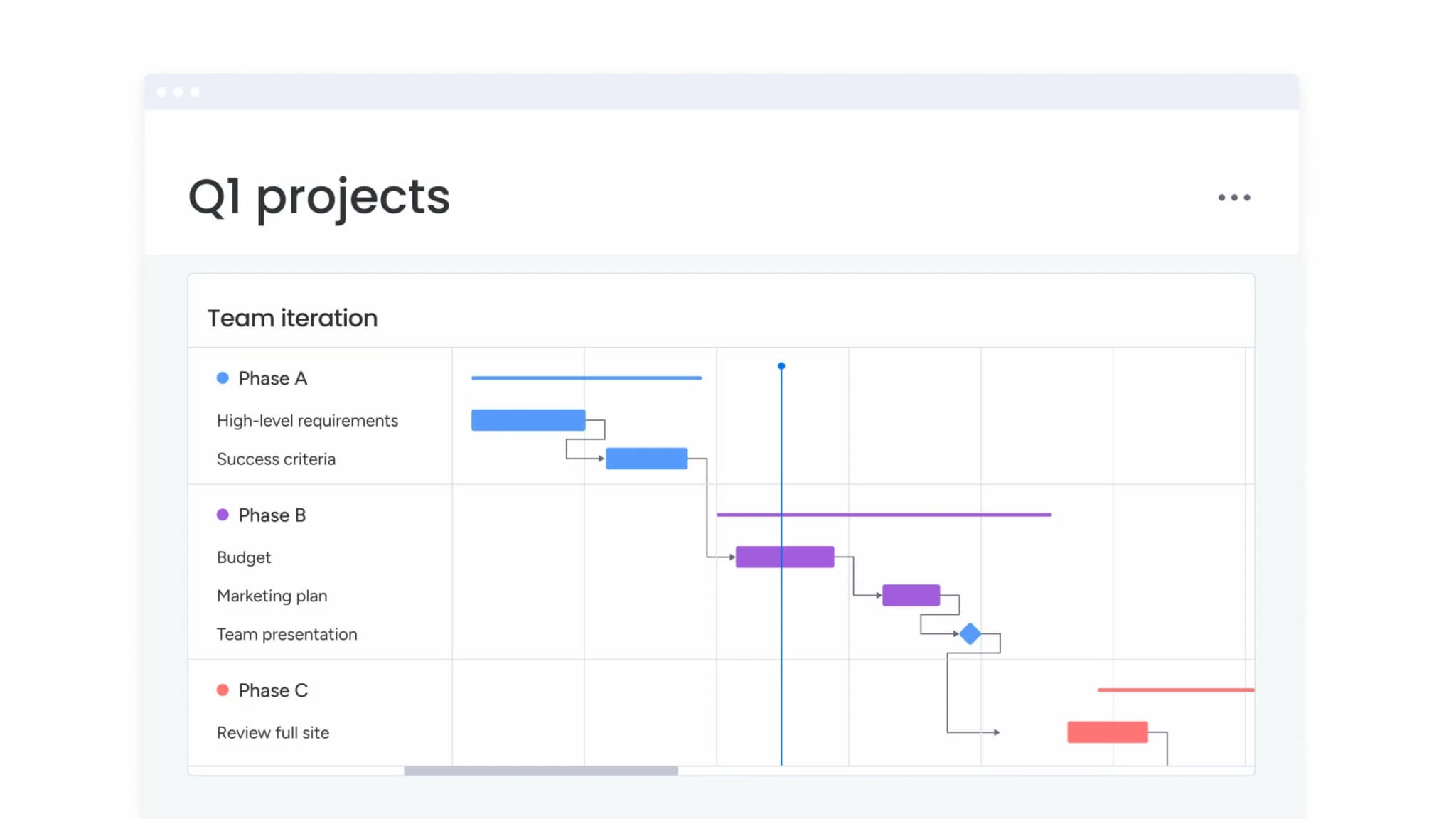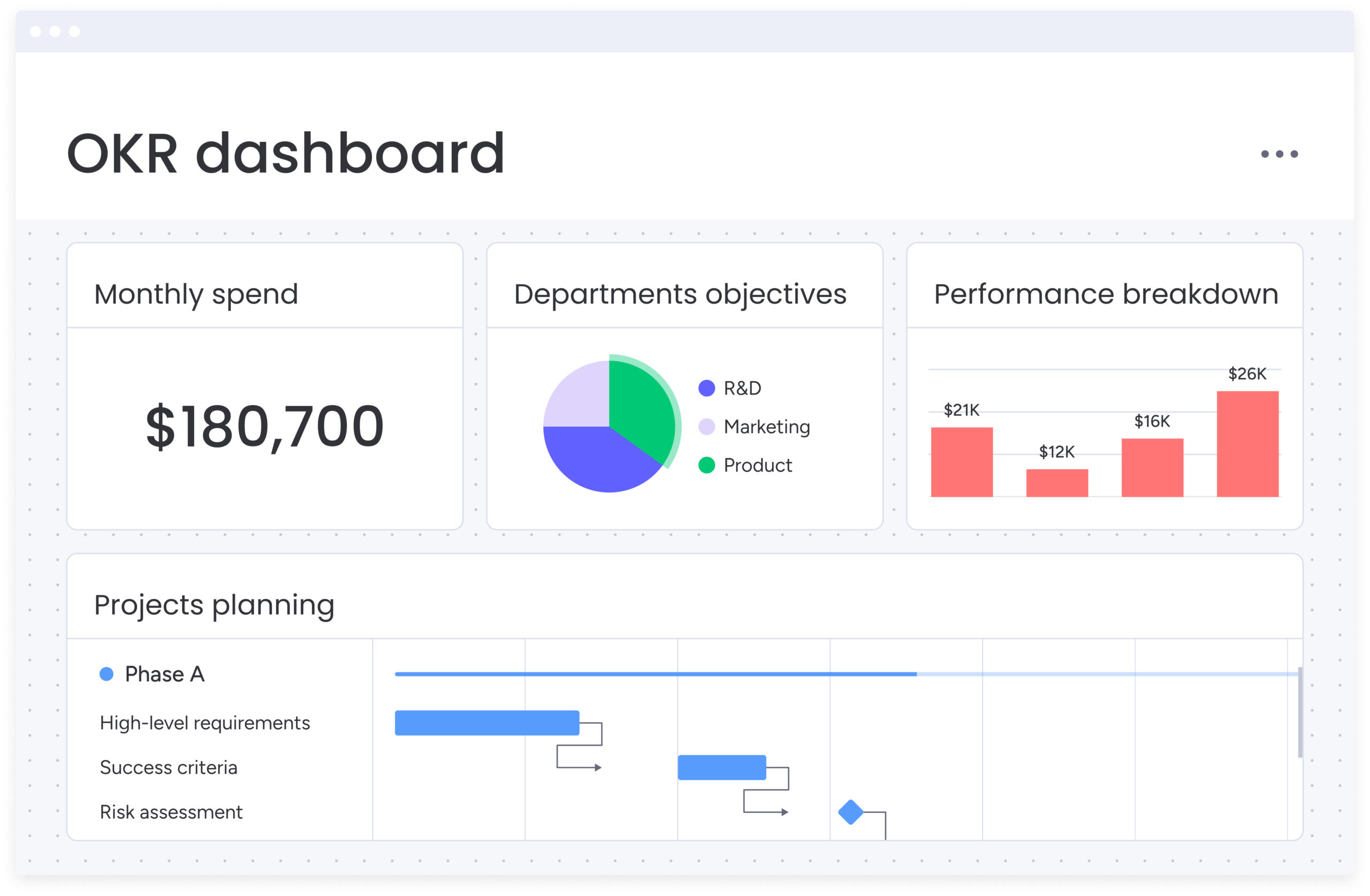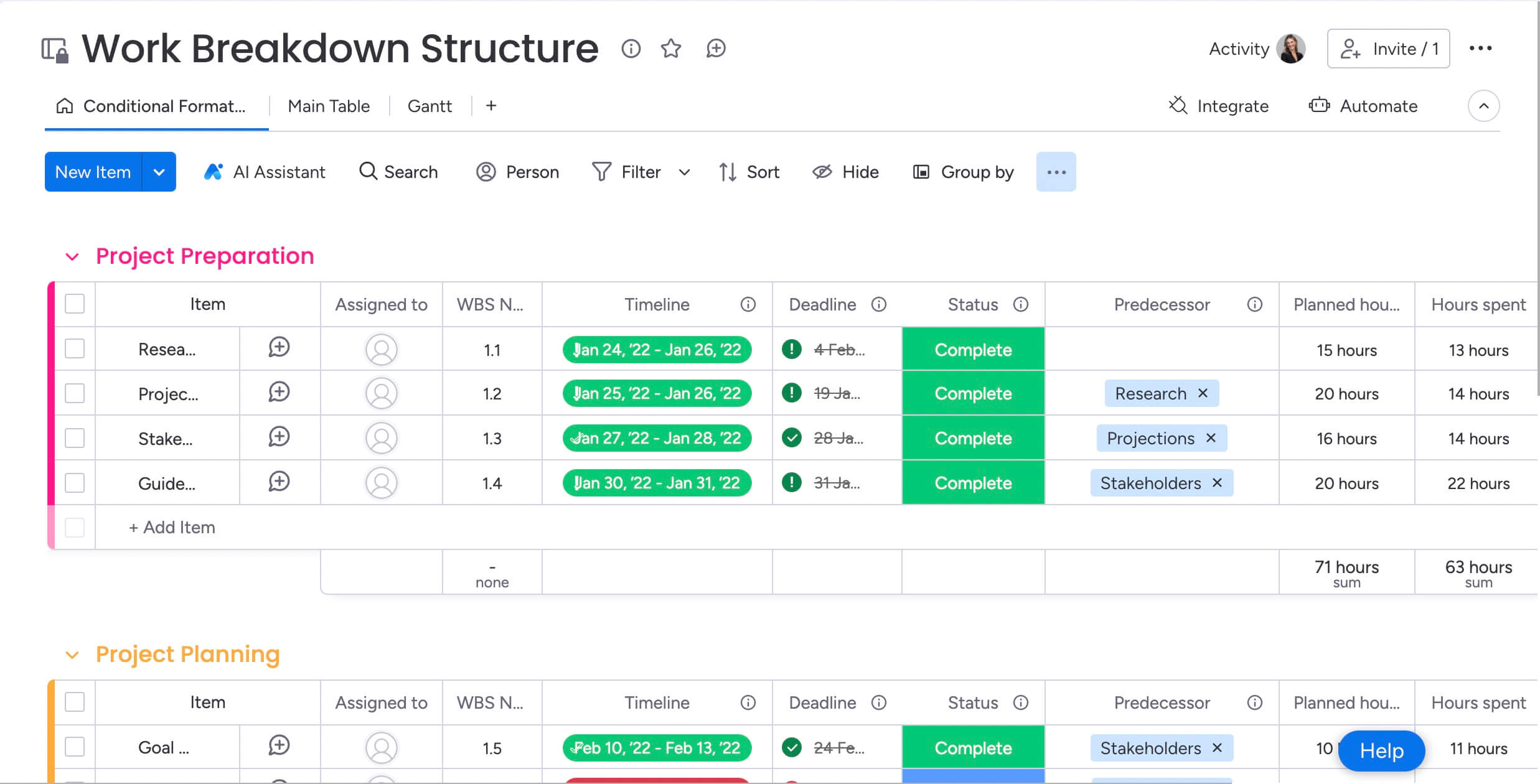Organizations face a constant stream of requests from customers, partners, and internal teams. Without a system to manage this influx, teams often default to working on what feels most urgent, not what is most important. This is the core challenge that effective demand management solves, creating a bridge between what people want and what can actually be delivered.
Building this capability transforms reactive work into predictable, strategic execution. It gives leaders the visibility to make smart investments and gives teams the focus to deliver their best work. The right platform provides the structure to connect strategy to daily operations, ensuring everyone is aligned and moving in the same direction.
This guide breaks down the essential components of a strong demand management process, from forecasting and resource allocation to streamlined request intake.
Key takeaways
- Structured workflow replaces chaos: demand management transforms operational chaos into a structured workflow by creating a single system to collect, evaluate, and prioritize all work requests across your organization.
- Strategic alignment drives performance: with a proper demand management system, teams can focus their resources on high-impact work, keep critical initiatives on schedule, and align daily efforts with strategic goals to improve team morale and performance.
- Centralized visibility with work management solutions: modern platforms like monday work management centralize all demand in one place with automated workflows, real-time capacity tracking, and AI-powered insights that adapt to your organization’s needs.
- Scalable foundations for long-term success: success requires transparent prioritization frameworks, cross-functional collaboration, and scalable processes that grow with your organization’s needs.

What is demand management?
Demand management is the process of forecasting, planning, and managing current and future requirements for products or services. This means understanding what your customers and internal teams need, when they need it, and how to allocate your resources to meet those needs efficiently.
It serves as the bridge between stakeholder requirements and organizational capacity. This enables informed decision-making about resource allocation, including time, personnel, and budget distribution.
Understanding demand management
Demand management covers both external customer needs and internal organizational requirements. External demand includes things like customer orders, which rely on order management, service requests, and market trends. Internal demand covers project requests from different departments, resource needs for new initiatives, and capacity requirements for ongoing operations management.
The process brings structure to how you collect, analyze, and respond to all these different needs. Instead of reacting to whoever shouts loudest, you create management systems for making informed decisions about what work to prioritize.
Who benefits from demand management?
When demand management works well, everyone wins. But different roles see different advantages:
- Executives: get visibility into how resources align with strategic goals and where investments deliver the most value.
- Managers: can balance team workloads effectively and set realistic expectations with stakeholders.
- Teams: work on priorities that matter most and avoid the chaos of constantly shifting demands.
The key is that demand management creates transparency. Everyone understands what’s being worked on and why it matters, which is critical given that employees who understand how success is measured are 2x more likely to feel motivated.
Real-world demand management example
Picture a marketing team getting campaign requests from sales, product, and customer success teams. Without demand management, these requests come through email, Slack messages, and hallway conversations. Nobody knows what’s already in progress or how new requests fit with existing priorities.
With demand management, all requests flow through a single intake process. The team evaluates each request against strategic goals and available capacity. They can tell stakeholders exactly when work will be delivered and why certain projects take priority. This transforms chaos into predictable execution.

Why does demand management matter now?
Your teams face more complexity than ever. Projects span multiple departments, priorities shift weekly, and everyone needs everything done yesterday, underscoring the importance of time management in project management. Without a system to manage competing demands, work becomes reactive and strategic goals get lost in the shuffle.
Rising complexity across organizations
Modern work doesn’t happen in silos. A single project might involve marketing, sales, product, and operations teams. Each team has its own priorities, timelines, and resource constraints.
This interconnected nature makes it hard to see the full picture. You might commit to a new initiative without realizing your design team is already overloaded. Or you might have teams duplicating efforts because they don’t know similar work is happening elsewhere.
The true cost of mismanaged demand
When demand management fails, the impact goes beyond deadline management. The consequences include:
- Strategic misalignment: teams work on low-impact projects while critical initiatives lack resources.
- Resource waste: multiple teams tackle similar problems without coordination.
- Employee burnout: unpredictable workloads and unrealistic expectations drive top performers away. Research shows employees who feel they have adequate time to complete their work are 70% less likely to burn out.
- Customer disappointment: broken promises and delayed deliveries damage your reputation.
Strategic value for modern businesses
Strong demand management creates competitive advantages. You can respond faster to market opportunities because you know exactly what capacity you have available. In fact, McKinsey & Company found that 83% of executives identify resource allocation as the most critical management lever for spurring growth. You deliver on commitments because you only promise what you can actually achieve.
Modern work management platforms help organizations build this capability by providing real-time visibility into workloads, priorities, and capacity across teams. Instead of guessing whether you can take on new work, you know.

Demand management vs. related concepts
Several disciplines sound similar to demand management but serve different purposes. Understanding these distinctions helps you implement the right processes and avoid confusion about who does what.
How does demand management differ from demand planning?
While these terms sound similar, they serve distinct purposes:
- Demand planning: focuses specifically on forecasting what customers will buy, using statistical models and market analysis to predict product demand over different time periods.
- Demand management: takes a broader view, encompassing customer demand plus all internal requests for resources, projects, and capacity across your organization.
The key difference: demand planning asks “what will customers want?” while demand management asks “what work needs to be done and how do we prioritize it?”
Demand management vs. capacity management
Capacity management looks at your available resources: how many people you have, what skills they possess, and how much time they can dedicate to work. It’s about understanding your supply side.
Demand management focuses on the incoming requests and requirements. It’s about understanding and organizing what people are asking for. These two disciplines work together but from opposite directions.
Understanding demand management vs. demand generation
Demand generation creates new customer interest through marketing campaigns, content, and outreach. Its goal is to increase the volume of potential customers.
Demand management organizes and prioritizes existing demand from all sources. Rather than creating more demand, it ensures you handle current demand effectively.
| Concept | Focus | Key Question | Example |
|---|---|---|---|
| Demand planning | Customer product needs | What will customers buy? | Forecasting holiday sales |
| Capacity management | Available resources | What can we deliver? | Team bandwidth analysis |
| Demand generation | Creating customer interest | How do we attract customers? | Marketing campaigns |
| Demand management | Organizing all demands | What should we work on? | Prioritizing project requests |

7 essential components of demand management
Building effective demand management requires several interconnected pieces working together. Each component addresses specific challenges while contributing to your overall ability to manage competing priorities.
1. Demand forecasting and analysis
You need reliable ways to predict what’s coming. This means analyzing patterns in past requests, understanding seasonal variations, and staying connected to business strategy changes.
Good forecasting combines hard data with human insight. Your data shows patterns, but your team members know about upcoming initiatives that haven’t hit the system yet.
2. Strategic resource allocation
Matching resources to demands requires more than checking who’s available. You need to consider skills, development goals, and strategic priorities to make optimal resource allocation assignments.
This component ensures you’re not just filling slots but making thoughtful decisions about how to deploy your most valuable asset: your people,which is central to resource management.
3. Priority management frameworks
Objective methods for ranking competing demands help you focus on what matters most. Popular frameworks include:
- RICE: Reach, Impact, Confidence, Effort.
- MoSCoW: Must have, Should have, Could have, Won’t have.
- Value scoring: custom point systems based on strategic alignment.
These frameworks remove politics from prioritization and create transparent decision-making.
4. Streamlined request intake
Standardized processes for submitting requests ensure you capture all necessary information upfront. This typically involves forms that guide requesters through providing context, requirements, and constraints.
Modern work management platforms offer custom intake forms that automatically populate your workflow boards. This eliminates back-and-forth clarification and speeds up evaluation.
5. Dynamic capacity planning
Real-time visibility into team workloads prevents overallocation and identifies opportunities for additional capacity planning. You need to see not just who’s busy, but what they’re working on and when they’ll have availability.
Modern widgets provided by platforms like monday work management show exactly this: current allocation, upcoming commitments, and capacity trends across your teams.
6. Real-time performance tracking
Dashboards and reports show how well you’re fulfilling demand and where bottlenecks occur. Key metrics might include cycle time, on-time delivery rates, and resource utilization.
This visibility enables continuous improvement by highlighting patterns and opportunities for optimization.
7. Continuous process improvement
Regular evaluation ensures your demand management processes evolve with your organization. Collect feedback, analyze performance data, and make adjustments to improve outcomes.
Try monday work management
The 5-step demand management process
Implementing demand management doesn’t happen overnight. This practical framework helps you build capability systematically while delivering value at each stage.
Step 1: analyze past performance data
Start by understanding your current state. Review completed projects to see how long different types of work actually took, what resources were required, and where delays occurred. Look for patterns in request volumes, approval times, and delivery cycles. This baseline helps you set realistic expectations for future work.
Step 2: forecast future demand patterns
Use your historical analysis plus business intelligence to predict upcoming needs. Consider regular operational work, seasonal variations, and strategic initiatives on the horizon. Build multiple scenarios including best-case, worst-case, and most likely. This preparation helps you adapt when conditions change.
Step 3: build demand management strategies
Create clear policies for how you’ll handle different types of requests. Define evaluation criteria, approval processes, and escalation paths. Document these so everyone understands how decisions get made. Establish who owns different parts of the process. Clear accountability prevents requests from falling through the cracks.
Step 4: match resources to demand
Assign people based on skills, availability, and development goals — not just who’s free. Consider the strategic importance of work when making allocation decisions. Modern work management platforms help here by showing you team capacity, skills, and current assignments in one view. You can make informed decisions about who should work on what.
Step 5: monitor and optimize results
Track how well you’re meeting commitments and where improvements are needed. Use this data to refine your forecasting, adjust your processes, and demonstrate value to stakeholders. Regular reviews keep your demand management practices aligned with changing business needs.
Try monday work management
Overcoming demand management challenges
Even solid demand management systems hit roadblocks. Recognizing common challenges and their solutions helps you maintain momentum when things get difficult.
- Managing multiple competing priorities: when everything seems urgent, you need clear criteria for making trade-offs. Without this, the loudest voice wins and strategic work gets delayed. Create transparent scoring systems that evaluate requests against consistent criteria. Publish these criteria so stakeholders understand how decisions get made. Hold regular priority reviews where trade-offs can be discussed openly.
- Breaking down departmental silos: only 61% of employees in large enterprises are satisfied with transparency. Marketing might struggle with design capacity while the product team’s designer has availability. Implement cross-functional planning sessions where teams share upcoming needs, an opportunity for resource leveling to ensure balanced workloads across departments.
- Adapting to rapid market changes: fixed processes can’t handle sudden shifts in priorities or market conditions. You need flexibility built into your system. Maintain buffer capacity for urgent requests. Create escalation procedures for true emergencies. Use shorter planning cycles so you can adjust course more frequently.
- Ensuring stakeholder buy-in: demand management only works when people use it. If stakeholders bypass your processes, you lose visibility and control. Start with a pilot program that demonstrates clear value. Focus on solving real problems that stakeholders experience. Involve them in process design so they feel ownership. Communicate wins regularly to maintain support.

Demand management best practices for success
Organizations that excel at demand management follow proven practices that maximize value while minimizing complexity. These practices create sustainable systems that balance stakeholder needs with organizational capacity, ensuring teams focus on high-impact work without getting overwhelmed by process overhead.
- Foster cross-functional collaboration: break down silos by creating shared goals and visibility across departments. When teams see how their work connects to broader objectives, they naturally collaborate more effectively. Advanced platforms like monday work management facilitate this through unified workspaces where all teams can see and contribute to shared goals.
- Embrace automation and AI capabilities: manual processes don’t scale. Automation handles routine tasks like request routing, status updates, and notification sending. This frees your team to focus on strategic decisions rather than administrative work. AI capabilities in solutions like monday work management can analyze demand patterns and suggest optimal resource allocations. These insights help you make smarter decisions faster.
- Create transparent governance structures: clear governance builds trust and encourages participation. Document who makes decisions, what criteria they use, and how conflicts get resolved. Make these structures visible to all stakeholders. When people understand how the system works, they’re more likely to work within it rather than around it.
- Build scalable processes: start simple and add complexity gradually. Your initial processes might be basic, but they should have room to grow without complete redesign. Choose platforms that can scale with you. Flexible architecture lets you start with simple workflows and add sophistication as your needs evolve.

Transform your demand management with monday work management
Managing demand effectively requires the right combination of processes, people, and technology. The platform provided by monday work management brings these elements together seamlessly.
- See all demand in one place: centralized visibility eliminates confusion about what work is requested and what’s in progress. Custom boards capture different types of requests while maintaining consistent information for evaluation. Automated intake through WorkForms ensures requests include all necessary details.
- Automate request and approval workflows: automation moves requests through your evaluation process without manual intervention. Approvals route to the right people based on request type, value, or other criteria you define. Status updates happen automatically as work progresses.
- Optimize resources with AI-powered insights: the Workload widget shows real-time capacity across your teams. See who’s overloaded, who has availability, and how work is distributed. AI capabilities analyze patterns in your demand data to surface insights and recommendations.
- Scale without adding complexity: flexible building blocks adapt as your organization grows. Add new request types, modify approval workflows, or adjust capacity planning without starting from scratch. Templates standardize processes across teams while allowing customization where needed.

Start managing demand more effectively today
Demand management transforms how organizations handle competing priorities by providing the structure necessary to make informed decisions, set realistic expectations, and deliver on commitments consistently.
The benefits extend throughout your organization, from executives who gain strategic visibility to teams who can focus on clearly defined priorities. Effective demand management reduces operational stress, improves work quality, and ensures strategic goals are achieved.
Frequently asked questions
What is the difference between demand management and supply chain management?
Demand management focuses on forecasting and prioritizing all organizational needs, including projects, resources, and initiatives, while supply chain management specifically handles sourcing, procurement, and logistics for physical products and materials.
How do organizations measure demand management success?
Organizations track demand management success through metrics like on-time delivery rates, resource utilization percentages, cycle time from request to completion, and alignment between completed work and strategic priorities.
What are the most important demand management metrics to track?
Key demand management metrics include resource utilization rates, demand forecast accuracy, average cycle time, priority alignment scores, and stakeholder satisfaction ratings.
Can small organizations benefit from demand management practices?
Small organizations gain significant value from demand management by implementing simplified processes that prevent overcommitment, improve resource allocation, and create transparency around priorities without requiring complex systems, forming the backbone of small business management.
How does demand management work with agile project methodologies?
Demand management provides the strategic framework for prioritizing work that feeds into Agile backlogs, helping teams decide which initiatives to pursue while maintaining flexibility in how they execute sprints.
What role does artificial intelligence play in modern demand management systems?
AI enhances demand management by improving forecast accuracy through pattern recognition, automating routine prioritization decisions, and providing predictive insights about resource needs and potential bottlenecks.
